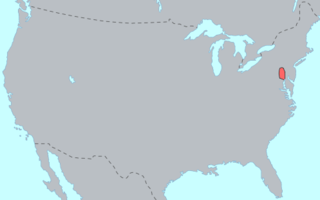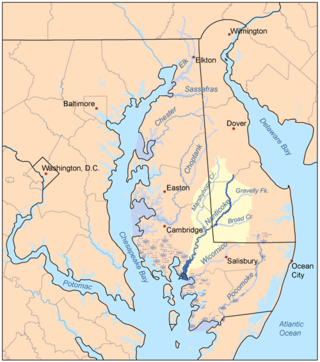Related Research Articles

Somerset County is the southernmost county in the U.S. state of Maryland. As of the 2020 census, the population was 24,620, making it the second-least populous county in Maryland. The county seat is Princess Anne.

Worcester County is the easternmost county of the U.S. state of Maryland. As of the 2020 census, the population was 52,460. Its county seat is Snow Hill.

Pocomoke City, dubbed "the friendliest town on the Eastern Shore", is a city in Worcester County, Maryland, United States. Although renamed in a burst of civic enthusiasm in 1878, the city is regularly referred to by its inhabitants simply as Pocomoke. The population was 4,184 at the 2010 census. It is part of the Salisbury, Maryland-Delaware Metropolitan Statistical Area. Pocomoke City is a center for commerce on the lower shore, home to an industrial park currently playing host to defense contractors, aerospace engineering, and plastics fabrication. Pocomoke City is located near the Wallops Island Flight Facility in Wallops Island, Virginia.

The Province of Maryland was an English and later British colony in North America from 1634 until 1776, when it made common cause with the group of Thirteen Colonies in rebellion against Great Britain and, finally in 1781—as the 13th signatory to the Articles of Confederation—it ratified its perpetual union with that group as the state of Maryland. The province's first settlement and capital was St. Mary's City, located at the southern end of St. Mary's County, a peninsula in the Chesapeake Bay that is bordered by four tidal rivers.

The Susquehannock, also known as the Conestoga, Minquas, and Andaste, were an Iroquoian people who lived in the lower Susquehanna River watershed in what is now Pennsylvania. Their name means “people of the muddy river.”

Francis Makemie (1658–1708) was an Ulster Scots clergyman, considered to be the founder of Presbyterianism in the United States of America.
Chief Walkara was a Shoshone leader of the Utah Indians known as the Timpanogo and Sanpete Band. It is not completely clear what cultural group the Utah or Timpanogo Indians belonged to, but they are listed as Shoshone. He had a reputation as a diplomat, horseman and warrior, and a military leader of raiding parties, and in the Wakara War.

The Nanticoke people are a Native American Algonquian people, whose traditional homelands are in Chesapeake Bay and Delaware. Today they live in the Northeastern United States and Canada, especially Delaware; in Ontario; and in Oklahoma.

The Big Bottom massacre was a mass killing perpetrated by Lenape and Wyandot warriors against American settlers on January 2, 1791. The massacre occurred near present-day Stockport, Ohio. It is considered part of the Northwest Indian Wars, in which native Americans in the Ohio Country clashed with American settlers, seeking to expel them from their territory.
The Treaty of Casco (1678) was a treaty that brought to a close the war between the Indigenous Dawnland nations and the English settlers. There are no surviving copies of the treaty or its proceedings, so historians use a summary by Jeremy Belknap in his 1784 History of New Hampshire.

The Yaocomico, also spelled Yaocomaco, were an Algonquian-speaking Native American group who lived along the north bank of the Potomac River near its confluence with the Chesapeake Bay in the 17th century. They were related to the Piscataway, the dominant nation north of the Potomac.
Nassawango Creek is a stream in the U.S. state of Maryland; it is the largest tributary of the Pocomoke River, located on the Delmarva Peninsula. Older variations on the same name include Nassanongo, Naseongo, Nassiongo, and Nassiungo, meaning "[ground] between [the streams]". Early English records have it as Askimenokonson Creek, after a Native settlement near its headwaters.

Naumkeag is a historical tribe of Eastern Algonquian-speaking Native American people who lived in northeastern Massachusetts. They controlled territory from the Charles River to the Merrimack River at the time of the Puritan migration to New England (1620–1640).
The Pocomoke people were a historic Native American tribe whose territory encompassed the rivers Pocomoke, Great Annemessex, Little Annemessex, and Manokin, the bays of Monie and Chincoteague, and the sounds of Pocomoke and Tangier.
The Assateague were an Algonquian people speaking the Nanticoke language who historically lived on the Atlantic coast side of the Delmarva Peninsula.
The Accomac people were a historic Native American tribe in Accomack and Northampton counties in Virginia. They were loosely affiliated with the Powhatan Confederacy.
Mary Kittamaquund, daughter of the Piscataway chieftain Kittamaquund, helped establish peaceful relations between English immigrants to the Maryland and Virginia Colonies and their native peoples.

The Indigenous peoples of Maryland are the tribes who historically and currently live in the land that is now the State of Maryland in the United States of America. These tribes belong to the Northeastern Woodlands, a cultural region.
The Annamessex people were a historic Native American tribe from the Eastern Shore of Maryland. Their homelands were part of present-day Somerset County, Maryland.
References
- 1 2 "Historical Markers - Marker Details". Maryland Historical Trust. Retrieved February 13, 2021.
- ↑ "Archives of Maryland, Volume 5 - Proceedings of the Council of Maryland, 1667-1687/8". msa.maryland.gov. p. 479. Retrieved February 13, 2021.